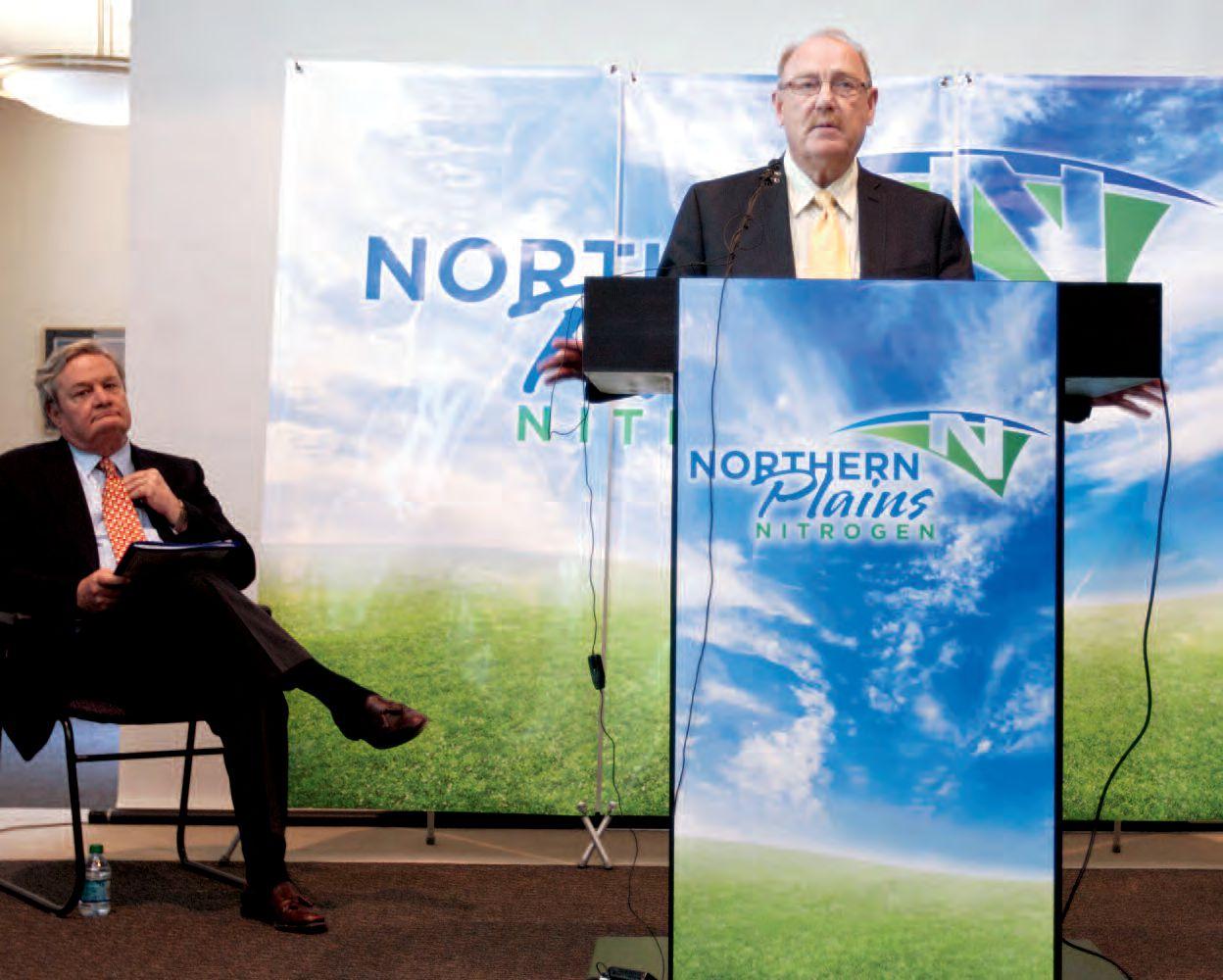
11 minute read
Need for Speed
North Dakota IT council sets out to map, improve state’s broadband infrastructure
BY KRIS BEVILL
As people and businesses become more reliant upon the Internet for day-to-day activities, the question of Internet access is no longer whether it’s available, but what kind of service is available? High-speed Internet service delivered via fiber optic networks is growing in importance as more people turn to the Internet to live-stream movies and upload videos at home and perform activities such as real-time content sharing and video conferencing at their offices. Significant bandwidth infrastructure is needed to avoid delays and crashes, but not everyone has
Doug Burgum, Arthur Ventures co-founder and former Great Plains Software/Microsoft executive, during a technology conference in Fargo. Burgum’s “Vision 2015” called for North Dakota to capitalize on its current economic success by utilizing public/private partnerships to make the state’s Internet speed and bandwidth infrastructure the best in the world by 2015, creating an environment that would attract new businesses and make it easier for existing businesses to expand.
Interested parties gathered for a series of informal discussions shortly after Burgum unveiled his vision and at its meeting in October, the ITCND’s board of directors agreed to champion a modified version of Burgum’s challenge, noting that it fits within the group’s goal of encouraging access to affordable, state-ofthe-art IT services for all North Dakotans. The group set a course to achieve “world-class” speed and infrastructure throughout the state via a phased plan, beginning with a proposal to complete an assessment of the state’s current broadband infrastructure, user demands, and economic impact, potentially followed by a pilot project in downtown Fargo. Completing those items is expected to cost about $75,000 and the group plans to move ahead with the project only after it obtains the full cost through pledges from ITCND members and other interested parties. Contributors will receive a seat on the initiative’s advisory board, providing them the opportunity to help direct future phases of the project, which could include additional pilot sites and the implementation of a statewide fiber network.
Why Fargo?
ITCND President Gary Inman is spearheading the initiative and has taken on the role of educating stakeholders and raising funds to complete the project. By mid-November, the project had not been fully funded, although it appeared likely it would be by the end of the month, and a tentative plan was in place to send out a request for proposal in mid-December for engineering firms to submit plans for the feasibility, supply/demand and economic impact studies.
Inman says initial reactions from economic developers and stakeholders throughout the state have been positive, albeit with some expected skepticism over the choice of Fargo as a pilot site. However, he says after people see the statistics for Internet in Fargo compared to elsewhere in the state, it becomes quite clear why North Dakota’s largest city was selected as a starting point.

Data available from Ookla, a globally recognized broadband testing network, shows a distinct difference in Internet speed and cost for Fargo compared to other cities in the state, including neighboring West Fargo. On Nov. 10, for example, Ookla showed Fargo’s download speed at about 16 megabits per second (Mpbs) compared to 24 Mpbs in West Fargo. Meanwhile, users were enjoying nearly 27 Mpbs in Grand Forks and about 29 Mpbs in Bismarck. For today’s average user, a minimum of 10 Mpbs would adequately support most activities. However, 50 Mpbs is considered fairly standard high-speed bandwidth currently. By comparison, 1 gigabit per second (Gbps), the equivalent of 1,024 Mpbs, is the intiative’s initial bandwidth target for a fully deployed fiber network, in anticipation of rapidly increasingly bandwidth demands in the future.
Fargo users are also paying significantly more for Internet access compared to other cities in the state, according to the Ookla index. The Nov. 10 data showed that Fargo users were paying about $5 per Mbps, compared to about $1.50 per Mbps in Grand Forks.
Aside from the speed and cost issues in Fargo indicated by Ookla data, ITCND selected Fargo for its first pilot site based on the fact that while rural telecommunications providers have access to federal funds to support fiber network installations, urban providers are not offered the same level of financial assistance. Therefore, while notable headway has been made in expanding fiber networks to rural areas, resulting in existing examples of 100 percent high-speed coverage areas in some parts of the state, there is no such example in the state’s cities.
“There’s actually a significant amount of fiber already in the ground all across the state and a couple of pockets that are already in this 100 percent mode, where we’d like the entire state to get to,” Inman says. “We already know what a rural piece of this would look like. We don’t know fully what the urban part would be.”
Affordability Test
Service providers say they are willing to support the initiative, but argue that Fargo’s connectivity issue is not from a lack of infrastructure. Rather, they believe users are simply either unaware of the services available to them or choose not to pay the price for high-speed connections.
“You could invest hundreds of millions of dollars to give every place in Fargo accessibility to 1 gigabit Internet, but not every building will be occupied by people who are willing to pay for it,” says Brian Crommett, sales and service manager for 702 Communications. “I don’t think it’s realistic to think Fargo will explode into this technology haven just because there’s fast Internet there.”
Crommett also points out that Ookla data may be somewhat misleading because it reports the median speed of actual use rather than availability. Therefore, while 50 Mbps is widely available throughout the city, if the majority of users purchase plans with less bandwidth, the overall speed test ratings would reflect that lower speed. “If our [Ookla] results are coming back under 20 Mpbs, it means people aren’t buying 50,” he says. “It’s not that they can’t get it. It’s that they aren’t paying for it.”
Installing fiber networks involves a substantial up-front investment by service providers in any environment. In urban areas, however, the complexities of installing around existing infrastructure, combined with a sometimes lengthy permitting processes, can make the installation particularly difficult and costly. Crommett says it costs service providers about $15 per foot to install fiber in Fargo, so providing fiber service to a multiblock area downtown could easily cost tens of thousands of dollars. Providers are willing to front the cost if they are guaranteed a market, but if it is unknown whether users in the building will sign up for service or if several providers are trenching in fiber to the same building, the potential to recoup those costs is greatly reduced. For that reason, Crommett says providers support the initiative’s goal of mapping “lit” buildings in downtown Fargo and highlighting areas that may be in need of service, although he believes in-need areas will be few. “We think it’s to every service provider’s benefit that the business community at large knows where the fiber is in town now and perhaps help us to identify areas that are underserved,” he says. “I know there are areas on the outskirts of town that don’t have access to high- speed, but I think everybody will be surprised to see how many buildings could have 1 gigabit Internet if they were interested in paying for it.”
Burgum suggested in his Vision 2015 that cash-rich North Dakota could financially support fiber network installation in some way, either by paying to install it or subsidizing the cost for providers to do it, in order to expand accessibility and reduce the cost to consumers. Service providers don’t want to risk losing the competitive advantage of installing service to a specific building or area, however, and are leery of any state or city involvement. The ITCND says it is exploring all options for private and/or public funding. In addition to soliciting private sector contributions, Inman plans to participate in a state legislative interim IT committee meeting this month to inform the committee of the initiative and obtain legislative input on possible solutions.
“I don’t know exactly what the right answer is,” he says. “Phase 1 is about gathering the data, looking at the specific problems and understanding the biggest challenges that drive cost. Once we know where the biggest cost-drivers are, we can start to look at how to provide changes.”
Gearing up for 1G
Inman emphasizes that the overall goal of the initiative is not just to improve access throughout the state now, but to anticipate the needs of the future and ensure that future user demands are met at an affordable price. It remains to be determined exactly what speed qualifies as “world-class speed” now or five years from now, or at what cost users would deem high-speed service affordable, but Inman hopes to identify those specifics during the initial phase mapping project and supply/demand analysis. He says the analysis will include discussions with the state’s agriculture, energy and health care industries and will also take into consideration future reliability of overall transmission infrastructure. He anticipates setting goals for high-speed availability expansions and costreduction measures after the mapping project and supply/demand analysis are complete, perhaps as early as mid- to late-January. “The data will tell us what goals we can set,” he says.
Travis Durick, broadband technology manager for North Dakota’s IT department, says the current state of broadband availability in the Peace Garden state is not bad, but it could be improved. For the past two years, Durick has served as program manager for the state’s federally funded broadband mapping project, which provides a general look at broadband availability throughout the state. He’s witnessed significant broadband expansion projects come to fruition in that time and believes high-speed access is improving overall, but he supports the Dakota Fiber Initiative and its mission to map broadband access on a more granular scale. “I think it’s great,” he says. “There are lots of community-oriented programs in the country looking at similar problems. It’s fun to see the business community get involved and start voicing their opinions as far as what they want to see in the future.”
Durick says whether the initiative settles on 1 Gbps as a goal or a lesser speed, he appreciates that equal emphasis is being given to upload and download speeds. “Download speed has been the focus for a long time but upload speed is becoming more and more important,” he says. “Internet connections are becoming less about content consumption and more about interaction — sending your video and content out has become just as important as seeing other content. I think that’s even more true in a business scenario — Internet collaborations, Internet conferencing — being able to leverage those connections is even more important for business.”
Crommet says that as bandwidth demands increase in coming years, so too will protocols to reduce the amount of bandwidth necessary for high-speed activities. Service providers are nonetheless intent on installing infrastructure to provide the highest-speed access possible to those who want it, he says. “The future is fiber and the future is gigabit and that’s what we are all working towards right now.” PB
Kris Bevill Editor, Prairie Business 701-306-8561, kbevill@prairiebizmag.com

Location, location, location
Centrally located Grand Forks plans for continued, sustained growth
BY KRIS BEVILL
Don Pottinger, Northern Plains Nitrogen CEO, announces plans to build and operate a $1.7 billion nitrogen fertilizer production facility near Grand Forks, N.D., during a news conference on May 9, 2013, in Grand Forks. At left is North Dakota Gov. Jack Dalrymple and at right is Larry Mackie, NPN chief operations officer. PHOTO: FORUM NEWS SERVICE other communities and is responsible for attracting many of its new and expanding businesses — location.

“Grand Forks is being looked at from a strategic location standpoint,” says Klaus Thiessen, president and CEO of the Grand Forks Region Economic Development Corp. The city provides a central base for access to both U.S. coasts, which is a selling point for several companies currently considering locating in Grand Forks, he says. Regionally, the city serves a mid-point between the Bakken oil fields in western North Dakota and Port of Duluth-Superior in Duluth, Minn. It’s proximity to thousands of college students is another selling point for businesses looking to establish or expand where workforce is readily available, he says.
Access to the Bakken
Certainly, the city’s easy access to the Bakken via U.S. Highway 2 is a selling point not lost on local leaders. About a year ago, a collaborative marketing effort was launched to attract Bakken-related companies to the community, emphasizing that companies could avoid dealing with workforce shortages and a lack of housing and business space by relocating to Grand Forks and commuting a few hours to the oil patch when necessary. The initiative achieved some initial success, drawing several manufacturers to the area. Among them was Steffes Corp., which having grown weary of the constant turnover at its Dickinson, N.D., plant, opened a Grand Forks facility at the end of 2012 in hopes that it would be able to attract and retain skilled workers.
Rodger Pearson, Steffes Corp.’s Grand Forks division manager, says the first year of operations has proven the company’s decision to be a wise one.
“The skilled and professional employees that we have hired since we opened have exceeded our expectations for safety, quality and productivity,” he says.
The company’s Grand Forks staff has grown from 27 employees at the end of last year to 80 employees currently and Pearson says he expects the company will continue to grow as it diversifies to serve other manufacturers in addition to the oil industry.
Grand Sky
Much attention is also being paid to the development of the UAS business park and the air base’s potential to become a federal UAS test site. In October, the U.S. Air Force announced its intent to sign an enhanced use lease with Grand Forks
County to develop the park, known as Grand Sky, on 217 acres at the air base. FD Stonewater and Lynxs Group was selected to develop the master plan for the park, which could possibly undergo construction beginning in the spring. Northrop Grumman has said it will anchor the park, creating anywhere from 50 to 500 jobs at its offices there. When complete, the park could provide up to 2,000 jobs over the next 20 years.
The attraction for both the business park and the test site again hinges heavily on location, in addition to an existing knowledge base and potential workforce. According to Theissen, the establishment of the business park was spurred by the fact that multiple higher learning institutions in the area provide UAS-related training, including Northland Community and Technical College in East Grand Forks and Thief River Falls, Minn.; the University of North Dakota in Grand Forks and Lake Region State College in Devils Lake, N.D. The Center for Unmanned Aircraft Systems Research, Education and Training is located at UND and the university is the first in the world to offer a four-year UAS degree.
“We have this base of education and training and, more importantly, we’re producing the people they need,” he says. “And we are at the leading edge. We’re not just saying we want to be, we are considered to be at the leading edge internationally in a number of areas for education and training.”
Value-Added Ag
The city’s economy is diversifying, but the mainstay of Grand Forks’ economy will continue to be value-added agriculture. A number of companies in this sector have recently announced expansions, including Philadelphia Macaroni Co., Reile’s Transfer and Delivery Inc., Black Gold Farms and True North Equipment. Thiessen says the presence of these types of companies and their recent expansions are very significant for the community and representative of the continued steady growth being experienced in the area due to a strong ag economy.
In May, Northern Plains Nitrogen announced plans to locate a $1.7 billion fertilizer plant near Grand Forks. The proposed plant will utilize natural gas from the Bakken to produce approximately 2,400 tons of ammonia per day, which will be converted to other products and utilized by farmers throughout the Midwest and several Canadian provinces.
NPN Chairman Darin Anderson says the company hopes to raise between $3 million and $9 million through private investors by the end of the year to support a front-end










